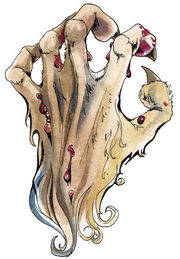Malar
Malar (pronounced MAHL-arr), The Beastlord, was the lesser deity of the hunt, evil lycanthropes, bestial savagery and bloodlust. His dogma concerned savage hunts, the spreading of the curse of lycanthropy, and general contempt for civilization. After the events of the Spellplague, he was an exarch of Silvanus.
History
At some point in the 1350s DR, Pasha Abon Duum of Manshaka had fortuitously been granted guardianship of the kittenlord, heir to the power of the cat lord, a minor power of felines. However, Duum desired to corrupt and dominate the child, and therefore made a deal with the mightier power Malar to keep the vengeful old Catlord off his back. Duum wished to use the cat lord’s power of planar travel to journey into the Outer Planes and, using the Claw of Malar, even challenge Tyr, god of justice, and gain awesome power. In exchange, when he was done with the boy, Duum would give him to the Beastlord. Learning of Duum’s wicked intentions for the boy, the Catlord came and rescued him, but Malar pounced upon the Catlord as he fled. The Catlord handed over the boy to the rogue Conner (who’d been guided onto the scene by the goddess Selûne) and, to buy time for him to carry the child away and hide him, fought Malar. The Catlord and Malar battled for three days and three nights, before the Catlord escaped, and it was a year before his wounds even healed. The scars would not. However, in the Year of the Prince, 1357 DR, Duum was tricked and thwarted and Tyr seized the Claw of Malar instead.
Relationships
Malar was one of the Deities of Fury, led by Talos. He held a long-standing alliance with Lolth against the Seldarine, and other dark deities like Bane and Loviatar. He fought against deities of peace, civilization, and nature, but held particular hate for Nobanion for defeating him in a battle during the Time of Troubles. Almost every other god hated him, including a number of other evil deities.
Although Malar and Silvanus were not fond of each other and typically viewed each other as opponents, after the events of the Spellplague, Malar became subject to Silvanus’ rule as a resident of the Deep Wilds. Despite this, Silvanus did not rein in Malar.
Worshipers
Malarites believed that it was an honor to Malar to make one’s killing bloody and long. His followers sometimes formed in bands, called “Hunts”. While forbidden to slay the young or the pregnant, Hunts typically followed his dogma and evoked wanton slaughter in Malar’s name. Malarites were generally frowned upon by civilization, as they tended to wreak havoc in their wake. One exception where the worship of Malar was allowed was in Cormyr.
One of the most respected servants of Malar was Garmos Saernclaws, who was responsible for the gospel of Saernclaws by which all priests of Malar were bound, ensuring that hunts remained clean and poison-free.
Holy Days
The High Hunt ritual was a vicious hunt in which a captured humanoid was released, and for the next day and night attempted to escape the prowling worshipers of the Beastlord. If they managed to survive, they won their freedom as well as, perhaps, other things.
The Feast of Stags day made Malar’s worship more tolerable in certain areas. During the harsh winters in the northern parts of Faerûn, Hunts chose a village in the wilderness, providing food for the people, with one or two Malarites pledging themselves to keeping the village fed through the snows.




Comments